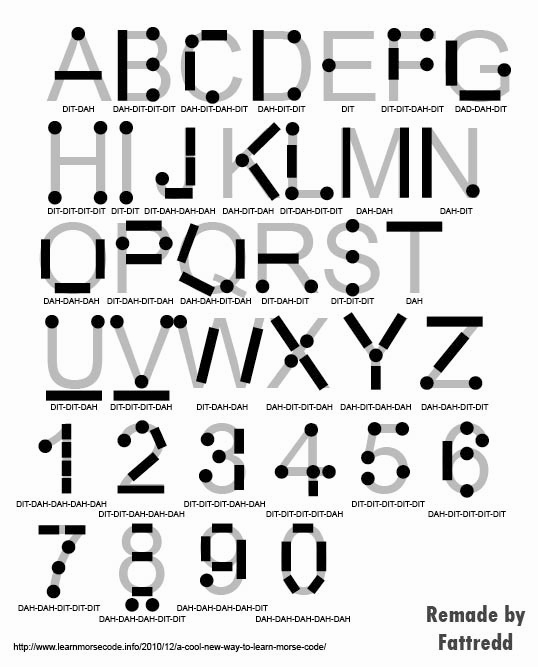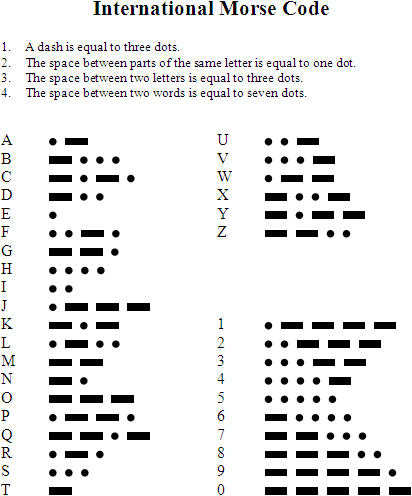Learning Morse Code is just like learning a new brand new language and as such needs a plan of attack and practice. Here are some ideas:
Morse Code Tip #1: Slow and Steady Wins the Race
Begin to learn Morse Code by starting out with the easiest and simplest letters in the alphabet.
Some of the easiest letters are:
- E (. or dit)
- T (- or dah)
- M (– 0r dah dah)
- I (.. or dit dit)
These Morse Code letters are the only letters in Morse Code that use one or two dits and dahs and do not combine the dits and dahs.
From there, the next easiest step is to move onto the simple dit and dah combinations, those using only 2 or 3 dits and dahs.
Here are the next Morse Code letters to learn:
- A (.- or dit dah)
- D (-.. or dah dit dit)
- G (–. or dah dah dit)
- (H) (…. or dit dit dit dit)
- K (-.- or dah dit dah)
- N (-. or dah dit)
- O (dah dah dah)
- R (.-. or dit dah dit)
- S (… or dit dit dit dit)
- U (..- or dit dit dah)
- W (.– or dit dah dah)
Finally, ending with the more difficult letters like “C”, “L”, “Q”, and “X”, that combine 4 dits and dahs in no particular “order”.
Here are the more difficult Morse Code letters:
- B (-… or dah dit dit dit)
- C (-.-. or dah dit dah dit)
- J (.— or dit dah dah dah)
- L (.-.. or dit dah dit dit)
- F (..-. or dit dit dah dit)
- Q (–.- or dah dah dit dah)
- P (.–. dit dah dah dit)
- V (…- or dit dit dit dah)
- X (-..- or dah dit dit dah)
- Y (-.– or dah dit dah dah)
- Z (–.. or dah dah dit dit)
Morse Code Tip #2: If at all possible, try to avoid visualization.
- Your ears hear the code
- Your mind says, “Hey, that’s Morse Code!”
- Your brain tries to bring up an IMAGE of the Morse Code letter or number you’ve heard
- Your brain tries to match the IMAGE to the SOUND
- Finally, you decide on a sound, or you miss the letter, and try to go on to the next letter
Morse Code Tip #3: Listen to Morse Code as often as you can.
Thanks to modern technology, you can find recordings of Morse Code just about anywhere – and you can find versions that are played back slower than what would be considered “normal” conversation.
Take advantage of these options to listen to More Code and use these recordings and videos as tools to test your learning progress.
This is especially important for learning the timing and spacing between letters and between words, as well as being able to instantly and effortlessly tell the difference between a dit and dah length of time.
Morse Code Tip #4: Use Your Own Voice!
Like most languages, Morse Code is both a written and auditory language. To prepare for listening to and translating dits and dahs, many people find it helpful to use their own voices to sound out letters and sentences as they practice.
Another way of incorporating the learners voice is to translate a short story, children’s book, or paragraph while recording. This is a great way of creating a simple test that can be “graded” without any outside assistance later.
Morse Code Tip #5: Have Fun!
As with learning anything, the more personal, entertaining, and a part of everyday life the new skill becomes, the quicker it is learned and the better it “sticks”. This can easily be applied to Morse Code. Emails, texting, grocery lists, notes to loved ones, and journaling are all great options for incorporating Morse Code into everyday life for a little bit of fun practicing as well as getting others around you interested in a new hobby as well!
Mac Learning Morse Code
Mac is an 8 year old attending regular classes and has Cerebral Palsy. He is quite the character and has a great sense of humor, and is using Morse Code to communicate!
Mac learned Morse Code through an Excel spreadsheet his mother created. It is a very nifty tool for learning Morse Code.
Here’s a video of him using two buttons to work with Morse Code, and here’s a link to Gina’s Excel spreadsheet she creating to help him learn Morse Code!
Learn Morse Code With Gina’s Excel Spreadsheet

Learn Morse Code in only 6 Steps
Morse Code – From a SmartPhone App?
W0w, I just came across http://buzzbuka.dsemeas.com/Buzzbuka.html which looks like its a pretty cool SmartPhone app for iPhone, Droid, or iPads.
It looks like you can communicate in either Morse Code or with a different type of code that is not Morse. Using your volume key buttons for dashes and dots, you can pound out a message to your friend in Morse Code.
But – that doesn’t solve the problem! You need to LEARN Morse code before you start using it in conversations with your friends.
Still, this app might be a great way to hone your skills and give you motivation to learn Morse Code – because if you don’t know the Code, how will you send it to your friends?
You won’t.
So, for $0.99 cents, why not? Give it a try. You’ll be sending and receiving Morse Code before you know it, and eventually may love it so much you decide to get your Ham Radio license!
A Cool New Way to Learn Morse Code
Wow, I found this cool new way to learn Morse Code. I’m not sure what it’s called, and I wish it was around when I learned Morse Code, but it’s pretty awesome.
Basically, Morse Code can be learned pretty easily visually. Once you have the visual Morse Code learned pretty well, you then need to start LISTENING for Morse Code. (You can look on the products section of this website to find kits and the such to help you learn to listen to Morse Code…)
I learned Morse Code out of an encyclopedia. It took me only about 2 hours of actual memorization. We used to pass noted in grade school written in Morse Code, and the coding/decoding also helped me to learn and retain it.
Anyways, back to the cool new way of learning Morse Code – check out this image:
If you memorize each letter individually, and then think back to it later, it’ll be somewhat easier to learn Morse Code. The only problem is timing – for instance, look at the Y. Y in Morse Code is “-.–” which is said, “dah-dit-dah-dah.” It’s tough to see in the picture above that the Morse Code Y should be that way, but at least you know that there are three lines and one dash, or three dah’s and one dit.
Does that make sense?
How I Learned Morse Code
When I was about 11 or 12 years old, I would come home from school to my father pounding away on a straight or paddle key sending Morse Code back and forth to some person from an unknown destination. I always wanted to know how to send and receive Morse Code, but I was never able to understand.
One day, I asked my father, “How do I learn Morse Code?” He sent me over the the Encyclopedia Britannica set that we have, and I studied Morse Code for days. I memorized the dots and dashes and was able to quickly learn Morse Code easily.
I was able to write down the entire Morse Code alphabet, but learning to hear Morse Code was a totally different story. Learning Morse Code by ear was much harder than learning Morse Code by looking at it from an encyclopedia! The only problem was that I learned the wrong version of Morse Code, and I had to re-learn the entire thing!
Today, it’s much easier to learn Morse code, especially since you can now learn Morse Code online!


